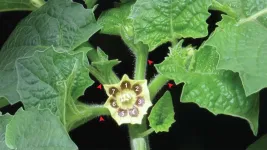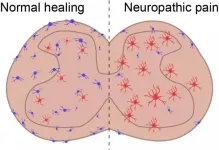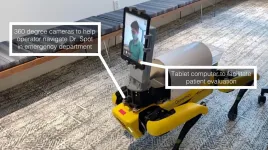WOX9: A jack of all trades
2021-03-04
(Press-News.org) Over evolutionary time scales, a single gene may acquire different roles in diverging species. However, revealing the multiple hidden roles of a gene was not possible before genome editing came along. Cold Spring Harbor Laboratory (CSHL) Professor and HHMI Investigator Zach Lippman and CSHL postdoctoral fellow Anat Hendelman collaborated with Idan Efroni, HHMI International Investigator at Hebrew University Faculty of Agriculture in Israel, to uncover this mystery. They dissected the activity of a developmental gene, WOX9, in different plants and at different moments in development. Using genome editing, they found that without changing the protein produced by the gene, they could change a plant's traits by changing the gene's regulation.
"Genes" are the DNA that code for proteins, but other nearby stretches of DNA regulate the activity of genes, instructing them where, when, and to what degree they should be active. With the genome-editing tool CRISPR, scientists can introduce precise mutations into DNA, including these regulatory regions. Though scientists would like to use CRISPR to fine-tune plant traits, the technique sometimes yields surprising results; some genes turn out to have functions that were previously unknown.
WOX9 is one of several "homeobox" genes that help plants and animals set borders in developing structures. While the gene plays a role in early development in arabidopsis, a weedy relative of broccoli, it influences later development--reproduction and flowering--in tomatoes. Lippman and Hendelman used CRISPR to create a series of mutations in the regulatory DNA surrounding WOX9 to reveal additional functions in tomato, groundcherry, and arabidopsis plants. Given the right regulatory sequence, the gene could induce more flowers to form in all three species. WOX9 is thus a candidate to increase yields in these and other crop plants just by changing its regulation. This discovery suggests that other genes may also have hidden multiple roles. Lippman says:
"We know about a whole bunch of genes that you might want to target with genome editing to improve crops, but there's a whole other set of genes for which they might have really useful functions that could also help improve crops. And so by using this approach, you can expose those roles and then you can predictably fine-tune the activity of that gene for that specific role to get the desired trait modification."
INFORMATION:
Lippman's team published their findings in the journal Cell. Their work will make it easier to improve crop traits more predictably.
[Attachments] See images for this press release:

ELSE PRESS RELEASES FROM THIS DATE:
2021-03-04
CHAPEL HILL, NC - One of the hallmarks of chronic pain is inflammation, and scientists at the UNC School of Medicine have discovered that anti-inflammatory cells called MRC1+ macrophages are dysfunctional in an animal model of neuropathic pain. Returning these cells to their normal state could offer a route to treating debilitating pain caused by nerve damage or a malfunctioning nervous system.
The researchers, who published their work in Neuron, found that stimulating the expression of an anti-inflammatory protein called CD163 reduced signs of neuroinflammation in the spinal cord of mice with neuropathic pain.
"Macrophages are a type of immune cell that are found in the blood and in tissues ...
2021-03-04
What The Study Did: In this study of return-to-play cardiac testing performed on 789 professional athletes with COVID-19 infection, imaging evidence of inflammatory heart disease that resulted in restriction from play was identified in five athletes (0.6%). No adverse cardiac events occurred in the athletes who underwent cardiac screening and resumed professional sports participation.
Authors: David J. Engel, M.D., of Columbia University Irving Medical Center in New York, is the corresponding author.
To access the embargoed study: Visit our For The Media website at this link https://media.jamanetwork.com/
(doi:10.1001/jamacardio.2021.0565)
Editor's Note: The article includes conflict of ...
2021-03-04
What The Study Did: Using reverse transcription-polymerase chain reaction testing, this study found that SARS-CoV-2 was present on the ocular surface in 52 of 91 patients with COVID-19 (57.1%). The virus may also be detected on ocular surfaces in patients with COVID-19 when the nasopharyngeal swab is negative.
Authors: Claudio Azzolini, M.D., of the University of Insubria in Varese, Italy, is the corresponding author.
To access the embargoed study: Visit our For The Media website at this link https://media.jamanetwork.com/
(doi:10.1001/jamaophthalmol.2020.5464)
Editor's ...
2021-03-04
What The Study Did: This study of more than 526,000 procedures across 17 institutions reports a significant decrease in the use of lasers and cryotherapy, retinal detachment repairs and other vitrectomies, beginning mid-March last year and lasting at least until May.
Authors: Mark P. Breazzano, M.D., of the Wilmer Eye Institute at Johns Hopkins Hospital in Baltimore, is the corresponding author.
To access the embargoed study: Visit our For The Media website at this link https://media.jamanetwork.com/
(doi:10.1001/jamaophthalmol.2021.0036)
Editor's Note: The article includes conflict of interest and funding/support disclosures. ...
2021-03-04
What The Study Did: Clinical trial registrations for COVID-19 interventions that were highly publicized during the COVID-19 pandemic compared with treatments not comparably promoted were assessed in this study.
Authors: Nadir Yehya, M.D., M.S.C.E., of the Children's Hospital of Philadelphia, is the author.
To access the embargoed study: Visit our For The Media website at this link https://media.jamanetwork.com/
(doi:10.1001/jamanetworkopen.2021.0689)
Editor's Note: The article includes conflicts of interest and funding/support disclosures. ...
2021-03-04
What The Study Did: Researchers evaluated the feasibility and acceptability of using a mobile robotic system to perform health care tasks such as acquiring vital signs, obtaining nasal or oral swabs and facilitating contactless triage interviews of patients with potential COVID-19 in the emergency department.
Authors: Giovanni Traverso M.B., B.Chir., Ph.D., of the Massachusetts Institute of Technology in Cambridge, Massachusetts, is the corresponding author.
To access the embargoed study: Visit our For The Media website at this link https://media.jamanetwork.com/
(doi:10.1001/jamanetworkopen.2021.0667)
Editor's Note: The article includes conflicts ...
2021-03-04
CAMBRIDGE, MA -- In the era of social distancing, using robots for some health care interactions is a promising way to reduce in-person contact between health care workers and sick patients. However, a key question that needs to be answered is how patients will react to a robot entering the exam room.
Researchers from MIT and Brigham and Women's Hospital recently set out to answer that question. In a study performed in the emergency department at Brigham and Women's, the team found that a large majority of patients reported that interacting with a health care provider via a video screen mounted on a robot was similar to an in-person interaction with a health care worker.
"We're ...
2021-03-04
How governments and companies should listen to the people on climate change
People are more engaged in reducing carbon emissions than previously thought - and governments, scientists and companies should listen to them - according to new research from the University of East Anglia and the UK Energy Research Centre.
A new study published today in Nature Energyy investigates how invested people are in making the changes needed to reduce carbon emissions and stop climate change.
The study shows that people, their views and actions should be included more when it comes to how we transform the way we use energy, to keep global average temperatures well below 2°C as set out in the Paris COP21 climate agreement.
Lead ...
2021-03-04
HOUSTON -- Contrary to long-held beliefs, Type I collagen produced by cancer-associated fibroblasts may not promote cancer development but instead plays a protective role in controlling pancreatic cancer progression, reports a new study from researchers at The University of Texas MD Anderson Cancer Center. This new understanding supports novel therapeutic approaches that bolster collagen rather than suppress it.
The study finds that collagen works in the tumor microenvironment to stop the production of immune signals, called chemokines, that lead to suppression of the anti-tumor immune response. When collagen is lost, chemokine levels increase, and the cancer is allowed ...
2021-03-04
Digital solutions including remote monitoring can help chronic pain sufferers manage their pain and reduce the probability of misuse of prescription opioids.
For chronic pain sufferers an app may be just the tool they need to manage their pain. In a UHN-led study that used the app "Manage My Pain" enrolled patients saw clinically significant reductions in key areas that drive increased medical needs, potential abuse of prescription opioids and of course, pain.
Toronto (March 4, 2021) - For the first time, an app has been shown to reduce key symptoms of chronic pain. A UHN-led study evaluated the impact of Manage My Pain (MMP), a digital health solution developed ...
LAST 30 PRESS RELEASES:
[Press-News.org] WOX9: A jack of all trades



